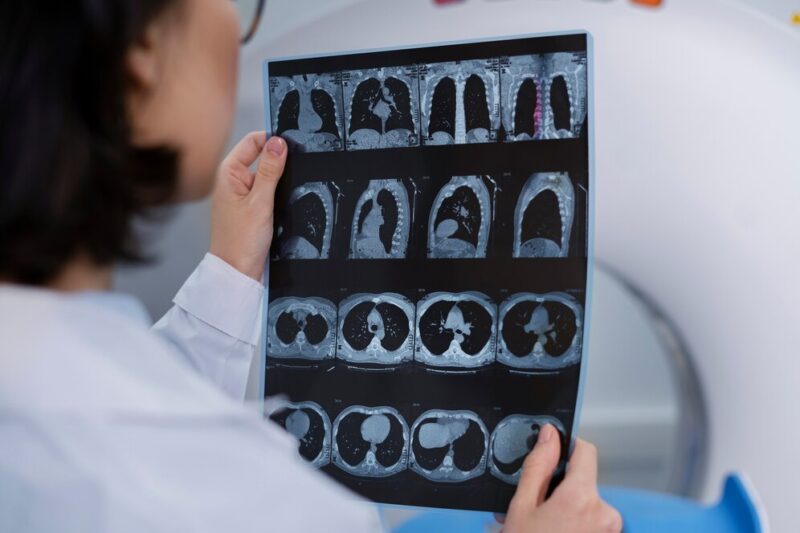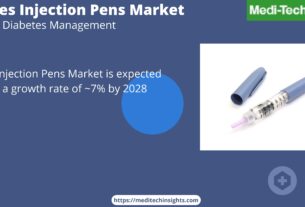The Contrast Media Market is projected to grow at a CAGR of 5-6% from 2024 to 2029. Key factors influencing the contrast media market include advancements in imaging technology, increasing prevalence of chronic diseases necessitating diagnostic imaging, rising demand for minimally invasive procedures, and growing healthcare expenditure globally.
Contrast media, also known as contrast agents or contrast dyes, are substances used in medical imaging to enhance the visibility of internal structures or fluids in the body. They work by altering the way X-rays, magnetic resonance imaging (MRI), computed tomography (CT), or other imaging techniques interact with tissues or fluids. These substances contain elements such as iodine or gadolinium, which have high atomic numbers and thus absorb more X-rays or alter magnetic properties. This makes them show up more clearly on imaging scans, allowing healthcare professionals to see details that might not be visible otherwise. Contrast media can be administered orally, injected into the bloodstream, or applied directly to the area being imaged, depending on the specific imaging technique and the part of the body being examined. They are commonly used in procedures such as angiography, CT scans, MRI scans, and certain types of X-rays to improve the clarity and accuracy of the images produced.
Get Sample Copy of Contrast Media Market: https://meditechinsights.com/contrast-media-market/request-sample/
Demographic Shifts and Market Dynamics: Impact on Contrast Media Demand
The contrast media market, which includes substances used in medical imaging procedures to enhance the visibility of internal body structures, is influenced by several key driving factors. As medical imaging technologies continue to evolve, there’s a growing demand for more effective contrast media to improve the accuracy and clarity of diagnostic procedures. Innovations such as MRI, CT scans, and ultrasound drive the need for better contrast agents. The increasing incidence of chronic diseases such as cardiovascular disorders, cancer, and neurological conditions necessitates frequent diagnostic imaging procedures. This leads to a higher demand for contrast media in various medical settings. For instance,
- In April 2023, GE HealthCare unveiled Clariscan (gadoteric acid) and Pixxoscan (gadobutrol). Pixxoscan (gadobutrol) is a macrocyclic, non-ionic gadolinium-based contrast agent (GBCA) for Magnetic Resonance Imaging (MRI), thereby broadening its portfolio of MRI contrast agents
- In September 2022, Bracco Diagnostics Inc., the U.S. subsidiary of Bracco Imaging S.p.A., revealed that the U.S. Food and Drug Administration (FDA) had granted approval for Gadopiclenol Injection, a novel macrocyclic gadolinium-based contrast agent with exceptional stability and the highest relaxivity among all GBCAs available in the United States, to be marketed by Bracco as VUEWAY (gadopiclenol) injection and VUEWAY (gadopiclenol) Pharmacy Bulk Package
With global demographics shifting towards an aging population, there’s a greater prevalence of age-related health conditions that require diagnostic imaging. Elderly individuals often require more frequent medical imaging procedures, contributing to the growth of the contrast media market. Increasing awareness about the importance of early disease detection and preventive healthcare measures has led to more people opting for regular health check-ups and screening programs. This, in turn, drives the demand for contrast media in diagnostic imaging. Ongoing research and development efforts are focused on creating contrast agents with improved safety profiles, better imaging properties, and reduced side effects. These advancements attract healthcare providers and patients alike, fueling market growth. Contrast media are increasingly being used in minimally invasive interventional procedures such as angiography, embolization, and biopsy guidance. The expanding scope of interventional radiology procedures further contributes to the growth of the contrast media market. As healthcare spending rises globally, there’s greater investment in diagnostic imaging infrastructure and technologies. This translates to increased procurement of contrast media by healthcare facilities, driving market growth.
Advancements in Contrast Agents: Shaping the Future of Medical Imaging
The contrast media market is continuously evolving, driven by advancements in medical imaging technologies and the growing demand for diagnostic procedures. Nanoparticle-based contrast agents are being developed to enhance imaging resolution and provide targeted imaging of specific tissues or organs. These nanoparticles can be engineered to carry contrast agents directly to the site of interest, improving imaging accuracy and reducing the amount of contrast agent needed. There’s a shift towards multiparametric imaging techniques, such as multiparametric MRI and PET/MRI, which combine multiple imaging modalities to provide comprehensive diagnostic information. Contrast agents tailored for specific imaging modalities are being developed to facilitate these multiparametric approaches. Researchers are exploring the development of biodegradable contrast agents that can be metabolized and eliminated from the body, reducing the risk of adverse reactions and long-term toxicity associated with traditional contrast agents. For instance,
- In March 2024, Lantheus Holdings, Inc. declared that the U.S. Food and Drug Administration (FDA) had approved the supplemental new drug application (sNDA) for DEFINITY (Perflutren Lipid Microsphere) to be utilized as an ultrasound-enhancing agent in pediatric patients with suboptimal echocardiograms.
AI algorithms are being integrated into imaging systems to assist radiologists in image interpretation and diagnosis. AI-powered image enhancement techniques can improve the visibility of contrast agents and enhance diagnostic accuracy. There’s a growing focus on personalized medicine in contrast-enhanced imaging, with the development of contrast agents that can be tailored to individual patient characteristics, such as age, gender, and medical history, to optimize diagnostic outcomes and minimize risks. With advancements in portable imaging devices, there’s an increasing trend towards point-of-care imaging, where contrast-enhanced imaging procedures can be performed directly at the patient’s bedside or in outpatient settings, facilitating faster diagnosis and treatment planning. Theranostic contrast agents, which combine diagnostic imaging capabilities with therapeutic properties, are being developed for targeted drug delivery and image-guided therapy. These agents enable simultaneous imaging and treatment of diseases, offering potential benefits in precision medicine. These emerging trends and technologies are shaping the future of the contrast media market, driving innovation in medical imaging and improving diagnostic accuracy and patient outcomes.
Regional Dynamics of the Global Contrast Media Market
The North America region dominates the global market with a strong presence of leading contrast media manufacturers and extensive research and development activities. The region’s market is characterized by robust healthcare infrastructure, increasing prevalence of chronic diseases, and rising demand for minimally invasive diagnostic procedures. Europe is a significant market for contrast media, driven by favourable government policies, increasing healthcare expenditure, and growing awareness about early disease detection. The market is characterized by a focus on product innovation, with emphasis on the development of advanced contrast agents and imaging techniques.
The Asia Pacific region is witnessing rapid growth in the contrast media market due to improving healthcare infrastructure, rising disposable incomes, and increasing investments in medical imaging technologies. Countries such as China, Japan, India, and South Korea are key markets in the region, driven by large patient populations and expanding healthcare facilities. Market growth is further fueled by initiatives to modernize healthcare systems, growing medical tourism, and increasing prevalence of chronic diseases.
Competitive Landscape
The key players in the contrast media market, include GE Healthcare, Bracco Imaging SpA, Bayer AG, Guerbet, Daiichi Sankyo Company and Lantheus Medical Imaging, Inc. among others.
Organic and Inorganic Growth Strategies Adopted by Players to Establish Their Foothold in the Market
Players operating in this market are adopting both organic and inorganic growth strategies such as collaborations, and acquisitions to garner market share. For instance,
- In December 2021, Bracco Imaging disclosed a worldwide strategic collaboration with Guerbet concerning Gadopiclenol, a high-relaxivity, macrocyclic contrast agent. Both Bracco Imaging and Guerbet will engage in manufacturing and contribute to research and development efforts for potential future applications of Gadopiclenol, with each party independently marketing the product under distinct brands
The Contrast Media Market continues to evolve alongside advancements in medical imaging technology and healthcare practices, with opportunities for growth driven by expanding applications and increasing demand for accurate diagnostic tools, strategic collaborations and aggressive organic and inorganic growth strategies followed by the players.
For more granular insights, please get in touch at https://meditechinsights.com/contact-us/


